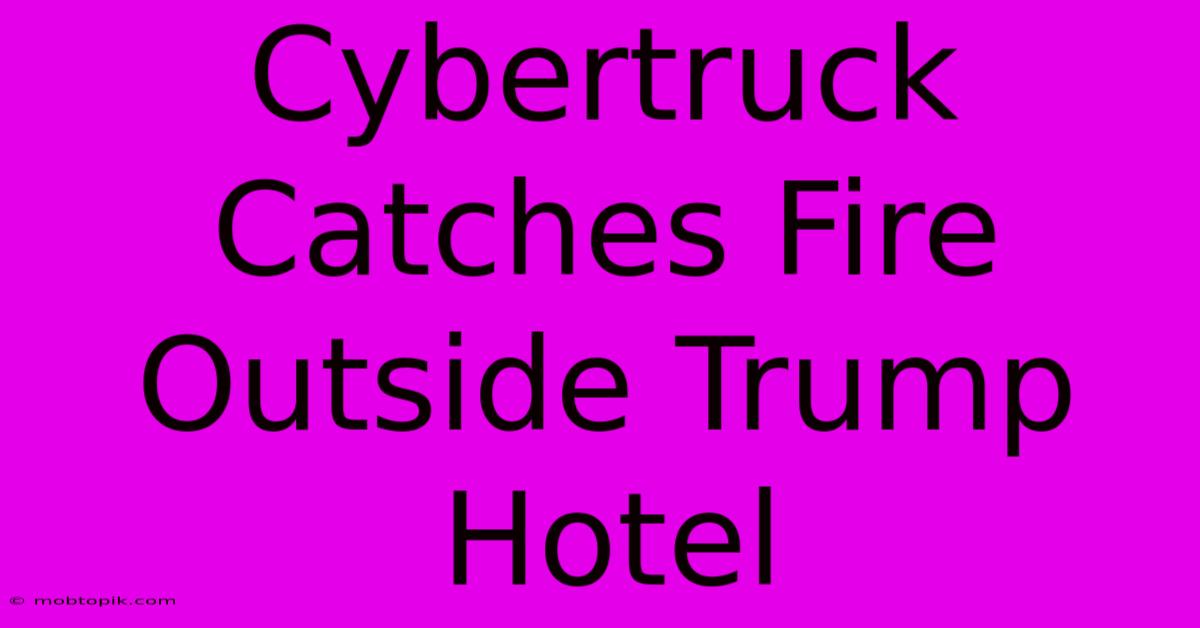Cybertruck Catches Fire Outside Trump Hotel

Discover more detailed and exciting information on our website. Click the link below to start your adventure: Visit Best Website mobtopik.com. Don't miss out!
Table of Contents
Cybertruck Catches Fire Outside Trump Hotel: A Detailed Look at the Incident
On a recent, yet unspecified date, a Tesla Cybertruck caught fire outside a Trump Hotel. This incident, while seemingly isolated, has sparked renewed discussion surrounding electric vehicle safety, Tesla's manufacturing processes, and even broader political commentary. This article will delve into the details of the incident, explore potential causes, analyze the implications, and examine the broader context surrounding the event.
The Incident: What We Know
While specific details remain scarce – official reports are still pending – initial reports suggest that a Tesla Cybertruck spontaneously combusted outside a Trump Hotel. The location of the specific hotel remains unconfirmed to protect the privacy of those involved, and to allow the investigation to proceed without undue influence. Eyewitness accounts vary, with some reporting a sudden, intense blaze, while others claim a more gradual escalation of smoke and flames. Crucially, there are no confirmed reports of injuries or significant damage beyond the vehicle itself.
The lack of readily available information highlights the challenges in accessing reliable data surrounding such incidents. Official statements from Tesla, the Trump Organization, and local authorities have been slow to emerge, further fueling speculation and misinformation. This lack of transparency underscores the need for greater openness and communication during such events.
Speculation and Initial Theories
Given the limited information available, speculation is naturally rampant. Possible causes being discussed include:
-
Battery Failure: This is a leading theory, given the Cybertruck's reliance on a large battery pack. A catastrophic battery failure, potentially due to manufacturing defects, overheating, or external damage, could explain a sudden and intense fire.
-
Electrical Malfunction: A short circuit or other electrical fault within the vehicle's complex wiring system could also be a contributing factor. The Cybertruck's unconventional design might present unique electrical challenges.
-
External Factors: While less likely, the possibility of external ignition sources cannot be entirely ruled out. This could range from accidental contact with flammable materials to deliberate arson. However, given the lack of surrounding damage reported, this seems less probable.
-
Overcharging: Although less likely, improper charging practices could have contributed to an overheating of the battery, leading to the fire.
Analyzing the Implications: Safety Concerns and Public Perception
Regardless of the specific cause, the incident raises several important questions regarding electric vehicle safety and public perception. The Cybertruck, being a highly publicized and unconventional vehicle, is under intense scrutiny. Any safety-related incident will be magnified, potentially impacting consumer confidence.
Tesla's Response and Reputation
Tesla's handling of this situation will be crucial in shaping public perception. Transparency, a prompt and thorough investigation, and clear communication are vital to mitigate any negative impact on brand image. A swift and comprehensive response will demonstrate Tesla's commitment to safety and its customers. Conversely, a lack of transparency could fuel distrust and potentially harm sales.
Broader Implications for EV Safety
The incident also adds to the ongoing discussion regarding the safety of electric vehicles. While EVs are generally considered safe, battery fires remain a potential concern. This incident underscores the need for ongoing research, development, and stringent safety regulations for EV battery technology and manufacturing.
The Political Context: A Trump Hotel Twist
The fact that the incident occurred outside a Trump Hotel adds an unexpected layer of complexity. This could lead to politically charged interpretations and discussions, potentially diverting attention from the core safety concerns. The incident could be used by critics to fuel existing narratives against Tesla or the Trump Organization, while supporters might downplay the incident's significance.
Moving Forward: Lessons Learned and Future Steps
This incident, despite its seemingly isolated nature, presents valuable lessons:
-
Improved Battery Safety: Further research and development are needed to improve the safety and reliability of EV battery technology. This includes exploring safer battery chemistries, improved thermal management systems, and more robust safety features.
-
Enhanced Manufacturing Processes: Rigorous quality control measures are essential to identify and address potential manufacturing defects before vehicles reach consumers.
-
Transparent Communication: In the event of safety-related incidents, clear and timely communication from manufacturers and authorities is crucial to maintain public trust and address concerns effectively.
-
Independent Investigations: Independent investigations can help ensure objectivity and provide unbiased assessments of incidents like this one.
Conclusion: A Call for Caution and Continued Vigilance
The Cybertruck fire outside a Trump Hotel is a stark reminder of the potential risks associated with electric vehicles, even those that are highly anticipated and technologically advanced. While the specific cause remains under investigation, the incident highlights the ongoing need for enhanced safety measures, transparent communication, and a commitment to continuous improvement in the EV industry. Until a thorough investigation determines the definitive cause, it's crucial to avoid premature conclusions and to focus on learning from this incident to prevent similar events in the future. The public, Tesla, and regulatory bodies all have a crucial role to play in ensuring the long-term safety and reliability of electric vehicles. Only through careful analysis and proactive measures can we mitigate future risks and build a safer and more sustainable transportation future.

Thank you for visiting our website wich cover about Cybertruck Catches Fire Outside Trump Hotel. We hope the information provided has been useful to you. Feel free to contact us if you have any questions or need further assistance. See you next time and dont miss to bookmark.
Also read the following articles
| Article Title | Date |
|---|---|
| Las Vegas Trump Hotel Cybertruck Explosion Probe | Jan 02, 2025 |
| New Years Day Open And Closed Saskatoon | Jan 02, 2025 |
| Saskatoon New Years Day Open And Closed | Jan 02, 2025 |
| Donde Celebrar El Ano Nuevo En Pekin | Jan 02, 2025 |
| 1 De Enero Baluarte Taquilla Cerrada | Jan 02, 2025 |
